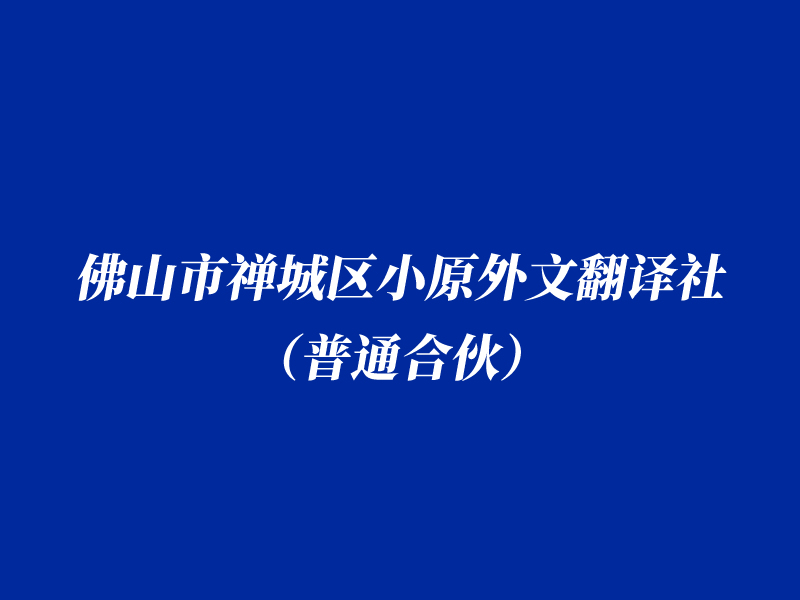Sep
2023
大家都知道在翻译的过程中,汉语的词汇对应着不同的英语词汇,因此在不同情况下有着不同的用法,今天佛山翻译公司带大家了解汉英翻译的方法有哪些?
We all know that in the process of translation, Chinese words correspond to
different English words, so they have different usages in different situations.
Today, Shangyu translation company will show you how to translate Chinese into
English?
一、增译法
1、 Incremental translation
指根据英汉
两种语言不同的思维方式、语言习惯和表达方式,在翻译时增添一些词、短句或句子,以便更准确地表达出原文所包含的意义。这种方式多半用在汉译英里。汉语无
主句较多,而英语句子一般都要有主语,所以在翻译汉语无主句的时候,除了少数可用英语无主 句、被动语态或"There
be…"结构来翻译以外,一般都要根据语境补出主语,使句子完整。英汉两种语言在名词、代词、连词、介词和冠词的使用方法上也存在很大差别。英语中代词使
用频率较高,凡说到人的器官和归某人所有的或与某人有关的事物时,必须在前面加上物主代词。因此,在汉译英时需要增补物主代词,而在英译汉时又需要根据情
况适当地删减。英语词与词、词组与词组以及句子与句子的逻辑关系一般用连词来表示,而汉语则往往通过上下文和语序来表示这种关系。因此,在汉译英时常常需
要增补连词。英语句子离不开介词和冠词。另外,在汉译英时还要注意增补一些原文中暗含而没有明言的词语和一些概括性、注释性的词语,以确保译文意思的完
整。总之,通过增译,一是**译文语法结构的完整,二是**译文意思的明确。
It refers to adding some words, short sentences or sentences to the
translation according to the different ways of thinking, language habits and
expressions of English and Chinese, so as to more accurately express the meaning
contained in the original text. This method is mostly used in Chinese
translation of miles. There are more Chinese sentences without subjects, while
English sentences generally have subjects. Therefore, when translating Chinese
sentences without subjects, except for a few English sentences without subjects,
passive voice or "there be In addition to the translation of structure, the
subject should be added according to the context to make the sentence complete.
There are also great differences in the use of nouns, pronouns, conjunctions,
prepositions and articles between English and Chinese. Pronouns are frequently
used in English. When it comes to human organs and things owned by or related to
someone, the possessive pronoun must be added before it. Therefore, it is
necessary to add the subject pronoun in C-E translation, and to delete it
appropriately according to the situation. The logical relations between English
words, phrases and phrases, and sentences and sentences are generally expressed
by conjunctions, while in Chinese, such relations are often expressed by context
and word order. Therefore, conjunctions are often needed in Chinese English
translation. Prepositions and articles are indispensable in English sentences.
In addition, when translating Chinese into English, we should pay attention to
adding some implicit but not explicit words and some general and explanatory
words to ensure the integrity of the translation meaning. In a word, adding one
meaning to the translation is to guarantee the integrity of the translation.
二、省译法
2、 Omission translation
这是与增译法相对应的一种翻译方法,即删去不符合目标语思维习惯、语言习惯和表达方式的词,以避免译文累赘。增译法的例句反之即可。
This is a translation method corresponding to the addition method, that is
to delete words that do not conform to the thinking habits, language habits and
expressions of the target language, so as to avoid unnecessary translation. The
example sentence of addition translation method is the opposite.
三、转换法
3、 Conversion method
指翻译过程中为了使译文符合目标语的表述方式、方法和习惯而对原句中的词类、句型和
语态等进行转换。具体的说,就是在词性方面,把名词转换为代词、形容词、动词;把动词转换成名词、形容词、副词、介词;把形容词转换成副词和短语。在句子
成分方面,把主语变成状语、定语、宾语、表语;把谓语变成主语、定语、表语;把定语变成状语、主语;把宾语变成主语。在句型方面,把并列句变成复合句,把
复合句变成并列句,把状语从句变成定语从句。在语态方面,可以把主动语态变为被动语态。
It refers to the conversion of parts of speech, sentence pattern and voice
in the original sentence in order to make the translation conform to the
expression mode, method and habit of the target language. Specifically, in terms
of part of speech, it is to transform nouns into pronouns, adjectives and verbs,
verbs into nouns, adjectives, adverbs and prepositions, and adjectives into
adverbs and phrases. In terms of sentence elements, the subject is changed into
adverbial, attributive, object and predicative; the predicate is changed into
subject, attribute and predicative; the attribute is changed into adverbial and
subject; and the object is turned into subject. In the aspect of sentence
pattern, the coordinate sentence should be changed into a compound sentence, a
compound sentence into a coordinate sentence, and an adverbial clause into an
attributive clause. In the aspect of voice, the active voice can be changed into
the passive voice.
四、正译法和反译法
4、 Positive translation and reverse translation
正译法和反译法:这两种方法通常用于汉译英,偶尔也用于英译汉。所谓正译,是指把句子按照
与汉语相同的语序或表达方式译成英语。所谓反译则是指把句子按照与汉语相反的语序或表达方式译成英语。正译与反译常常具有同义的效果,但反译往往更符合英
语的思维方式和表达习惯。因此比较地道。
The two methods are usually used for C-E translation and occasionally for
E-C translation. The so-called correct translation refers to the translation of
sentences into English in the same word order or expression as Chinese. The
so-called reverse translation refers to the translation of sentences into
English according to the word order or expression mode opposite to Chinese. The
former and the latter are often synonymous, but the latter is more in line with
the English way of thinking and expression habits. So it's more authentic.
上一篇:法语翻译怎样做好
下一篇:翻译公司的误区与解决方案
- [07-16] 翻译文学大量出现后,“翻译腔”不可避免
- [04-15] 口译笔记需要注意的事项
- [12-27] 智能翻译时代的五个关键特征
- [06-20] 俄语有怎样的翻译技巧
- [06-27] 我国同声传译人才为何不足?
- [08-10] 佛山如何做好产品检测报告翻译
- [05-02] 技术转向背景下的翻译研究新视野
- [08-30] 佛山论文翻译公司

-
地址1:佛山市禅城区汾江中路144号科华大厦1002室(创业大厦正对面)
电话:0757-82285965 13318391728
-
地址2:佛山市禅城区魁奇路澜石(国际)金属交易中心大厅一楼
电话:0757-82285965 13318391728




